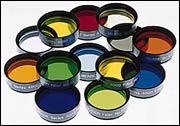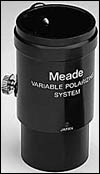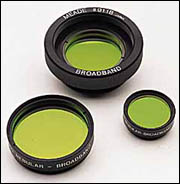
 |
MEADE FILTERS |
 |
For increased contrast and
resolution of the Moon and planets in visual or photographic applications. Color
filters are an essential tool of the lunar and planetary |
| Filters solve, or greatly reduce the effects of, two basic observing problems: (a) Irradiation is the fuzzying of a boundary between lighter and darker areas of the Moon or a planetary surface and can be caused either by the effects of highly contrasting light impacting the human eye or by the motion of the Earth's atmosphere, through which the observation is being made. (b) Contrast is the separation of adjacent surface regions according to their color; for example, a light green area on Mars can become mixed in the eye with an adjacent light yellow area, to the effect that the combined area appears yellow-green, unseparated into its component regions. | |
| The use of a Meade Series 4000 color filter can mean the difference between seeing small craterlets in the floor of Clavius on the Moon and not; it can mean the difference between seeing five or six whirls, festoons, and loops in Jupiter's north equatorial belt and seeing one or two; it can mean the difference between seeing the inner crépe ring of Saturn and not. Depending on atmospheric conditions on both the Earth and the planet being observed, the advantages of color filters can be anywhere from subtle to dramatic. | |
| Meade Series 4000 filters are a large 26mm in clear aperture and are manufactured from the purest crown optical glass, dyed-in-the-mass (not "color coated"); there are no finer filters available for telescopic applications. Each filter glass is anti-reflection coated on both sides and is mounted in a machined aluminum cell with the Wratten No. of the filter marked on the side of the cell. Filters may be piggybacked, or stacked, to achieve selective filtration of the visual color spectrum. | |
| For visual applications Series 4000 filters thread into the barrels of all Meade 1.25" eyepieces, and into the barrels of virtually all other 1.25" eyepiece brands as well. The eyepiece-with-filter can be placed in the eyepiece-holder of a Schmidt-Cassegrain telescope or Meade ED Apochromatic Refractor for Tele-Extender eyepiece-projection photography of the Moon and planets. The filters also thread into the barrels of the Meade Camera Adapter (1.25") and Variable-Projection Cameras Adapter. |  Series 4000 filters thread into the barrels of virtually all 1.25" eyepiece brands. |
| Recommended Series 4000 Filter Applications | |
| #8 Light Yellow (83% transmission): Useful in observing red and orange-colored phenomena in the belts of Jupiter and in enhancing the level of observable detail of small orange-red zonal features within the belts of the planet. Increases contrast of maria on Mars. Can result in improved resolution of dusky detail on Uranus and Neptune in instruments of 10" aperture and larger. A popular filter for the enhancement of lunar features, particularly in telescopes of 8" aperture and smaller. | |
| #11 Yellow-Green (78% transmission): Contrasts well with the red and blue characteristics of surface features on Jupiter and Saturn. Darkens the maria visible on Mars, and clarifies the Cassini division in Saturn's rings. | |
| #12 Yellow (74% transmission): Contrasts strongly with blue-colored features on Jupiter and Saturn, while enhancing red and orange features. Lightens red-orange features on Mars, while reducing or blocking the transmission, and thereby increasing the contrast, of blue-green areas. Useful in increasing the contrast of lunar features in telescopes 6" aperture and larger. | |
| #21 Orange (46% transmission): Reduces or blocks transmission of blue-green wavelengths. Use on Jupiter and Saturn to enhance detail in the belts and polar regions. Sharpens boundaries between yellow-orange areas and blue-green regions on Mars, resulting in a darkening of edge-detail in the maria. | |
| #23A Light Red (25% transmission): On telescopes of 6" aperture and larger the #23A does approximately the same functions as the #21 filter, but with stronger contrast and enhancement of marginally defined blue-green surface detail. Useful primarily on Jupiter, Saturn, and Mars. Increases contrast between Mercury and bright blue sky during daylight observations or during twilight. | |
| #25A Red (14% transmission): The #25A filter strongly blocks the transmission of blue and blue-green wavelengths, resulting in very sharply defined contrast between, for example, blue-tinted cloud formations on Jupiter and the lighter-toned features of the disc. Also useful for the delineation of the Martian polar ice caps and maria. Because of its relatively low total light transmission the #25A filter should be employed on telescopes of 8" aperture and larger. | |
| #38A Dark Blue (17% transmission): A popular filter for the study of Jupiter's disc, owing to the filter's strong rejection of orange and red wavelengths. Increases contrast between the reddish belt structures and enhances detail of the Red Spot. Also useful for the study of isolated phenomena, such as dust storms, on Mars, as well as the belt structure of Saturn. Increases contrast of subtle cloud markings on Venus. | |
| #47 Violet (3% transmission): Strongly rejects red, yellow, and green wavelengths; useful for the study of Martian polar cap regions and for the observation of occasional phenomena in the upper atmosphere of Venus. Enhances contrast between the rings of Saturn. Use only on telescopes of 8" aperture and larger. | |
| #56 Light Green (53% transmission): Excellent for the observation of Martian polar ice caps as well as yellow-tinted dust storms on the Martian surface. Increases contrast of the red and blue regions in Jupiter's atmosphere as well as in the cloud belts. Also useful for enhancing lunar detail. | |
| #58 Green (24% transmission): Use on telescopes 8" aperture and larger to reject blue- and red-toned structures on the surface of Jupiter and thereby increase their contrast relative to lighter parts of the disc. Also use for the enhancement of Saturn's cloud belts and polar regions. Strongly increases contrast of Mars' polar ice caps, and increases contrast of atmospheric phenomena on Venus. | |
| #80A Blue (30% transmission): A popular filter for the study of Jupiter and Saturn. Enhances contrast of rilles and festoons in Jupiter's cloud belts, as well as details of the Red Spot. Brings out detail in Saturn's belts and polar phenomena. Very useful as a contrast-enhancing lunar filter. | |
| #82A Light Blue (73% transmission): Useful on the Moon, Mars, Jupiter, and Saturn, this subtle pale blue filter enhances areas of low contrast while avoiding significant reduction of overall image brightness. A valuable filter to piggyback with other filters. | |
| ND 96 Moon Filter (0.9 density; 13% transmission): The neutral density filter transmits light uniformly across the entire visual spectrum. It serves as an excellent filter to reduce glare and irradiation when observing the Moon with any telescope 4" and larger. The ND96 filter may also be employed in the splitting of close double stars where one of the binary pair significantly exceeds the other in brightness. |
 |
#905
Variable Polarizing Filter (1.25"): For glare-reduction in observing the Moon the
#905 Variable Polarizer includes two Polarizer filters mounted in a specially-machined
cell. The #905 permits variable settings of the light transmission between 5% and 25%, to
account for varying lunar surface brightness according to the phase of the Moon and the
magnification and aperture of the telescope. Accepts 1.25" eyepieces. Item# MIC-07286 |
| Meade Series 4000™ Broadband Nebular Filters | |
 |
For dramatic increase in
visual and photographic detail in deep-space emission and reflection nebulae. Meade
Series 4000 Nebular Filters incorporate the very |
| Technical
Basis of the Meade Broadband Nebular Filter: As shown in the transmission graph below,
the Meade Broadband Nebular Filter strongly rejects the light of sodium- and mercury-vapor
lights as well as natural airglow and auroral emissions. Conversely, the strong nebular
emission spectral lines, transmitting in the visually sensitive regions primarily at 486nm
(Hydrogen Beta, or Hß) and 496 to 501nm (Oxygen-III, or OIII), are passed through the
filter with high transmission percentages. The effect of the filter is that nebular light
reaching the eye is observed visually in dramatically increased detail, while the effects
of unwanted city lights are greatly reduced. The Meade Broadband Filter also passes
photographically-important Hydrogen Alpha nebular light at 656nm largely unattenuated,
making the filter a valuable aid in the photography of deep-space emission nebulae as
well. The contrast between galaxies and the night-sky backdrop is also typically enhanced
by the filter, but because galaxies emit light in a much broader range of wavelengths than
nebulae, the effect is generally not as dramatic in these cases. Wavelength vs. Transmission graph of the Meade Broadband Nebular Filter: Undesirable spectral lines (suppressed by the filter) are indicated by blue lines on the horizontal axis; desirable spectral lines (passed by the filter) are shown in red. Three models of Broadband Nebular Filters are available: #908B: Threads into the barrels of all Meade 1.25" eyepieces,
and into the barrels #910B: Threads into the barrels of all
Meade 2" eyepieces, as well as most other 2" #911B: Threads onto the rear cells of
Meade LX-series mirror-lens telescopes and |
|
| Meade Series 4000™ Narrowband Nebular Filters | |
 |
A truly remarkable advance
for the serious visual observer of emission nebulae. Unlike the wide transmission band characteristics of the Broadband Nebular Filters, Meade Narrowband Filters zero in on the three most important visible wavelengths emitted by deep-space emission nebulae: the two spectral lines of Oxygen III at 496 and 501nm and the Hydrogen Beta line at 486nm. Virtually all unwanted city light emissions are rejected by factors of 99.9+%. |
| Because of its
extremely narrow bandpass characteristics, the Narrowband Nebular Filter achieves truly
striking levels of contrast between the nebula itself and the surrounding dark-sky
environment: objects such as the Orion Nebula (M42), the Lagoon Nebula (M8), and the Omega
Nebula (M17) are observed as they would normally appear through telescopes of several
inches larger aperture. Tenuous, faint outer extensions of these objects now become
strikingly observable–often to the point where the visible mass of the nebula is more
than doubled in diameter. Planetary nebulae such as the Ring Nebula (M57), the Dumbbell
Nebula (M27), and the Saturn Nebula (NGC7009) similarly display dramatically-heightened
levels of contrast and observable detail. Faint, insignificant patches of nebulosity that
heretofore were near the limit of observability now jump into view with startling ease. The Meade Narrowband Nebular Filter should be viewed as a complement to, not
as a substitute for, the Broadband Filter. The Broadband Filter enhances the
performance of a much wider range of nebular objects; the Narrowband Filter improves
contrast and visible detail on fewer objects, but in these more limited cases it does so
to the most dramatic level possible. Because of the very narrow range of total light
energy transmitted, the Narrowband Filter is not intended as a photographic filter. Visual
effects of the Narrowband Filter are most pronounced when the filter is used with
eyepieces of 25mm focal length and longer. #908N: Threads into the barrels of all
Meade 1.25" eyepieces and most other 1.25" brands. #910N: Threads into the barrels of all
Meade 2" eyepieces and most other 2" brands. #911N: Threads onto the rear cells of Meade LX-series mirror-lens telescopes and onto Meade ED Apochromatic Refractors, using the Universal Thread Adapter, Also threads to other brands of SCT's as well. Clear aperture: 36mm |
|
 |
Seasonal
Star Chart This star finder is best designed for night time, and outdoor use. Major stars are printed in luminous ink which glows in the dark. More than 1000 stars and deep sky objects are listed and charted. Seasonal Star Chart has information on various types of galaxies and nebulae. 20pgs. ITEM# MSD-T-2090 $19.95 |
| Orders: 1-800-701-STAR or Order Online |